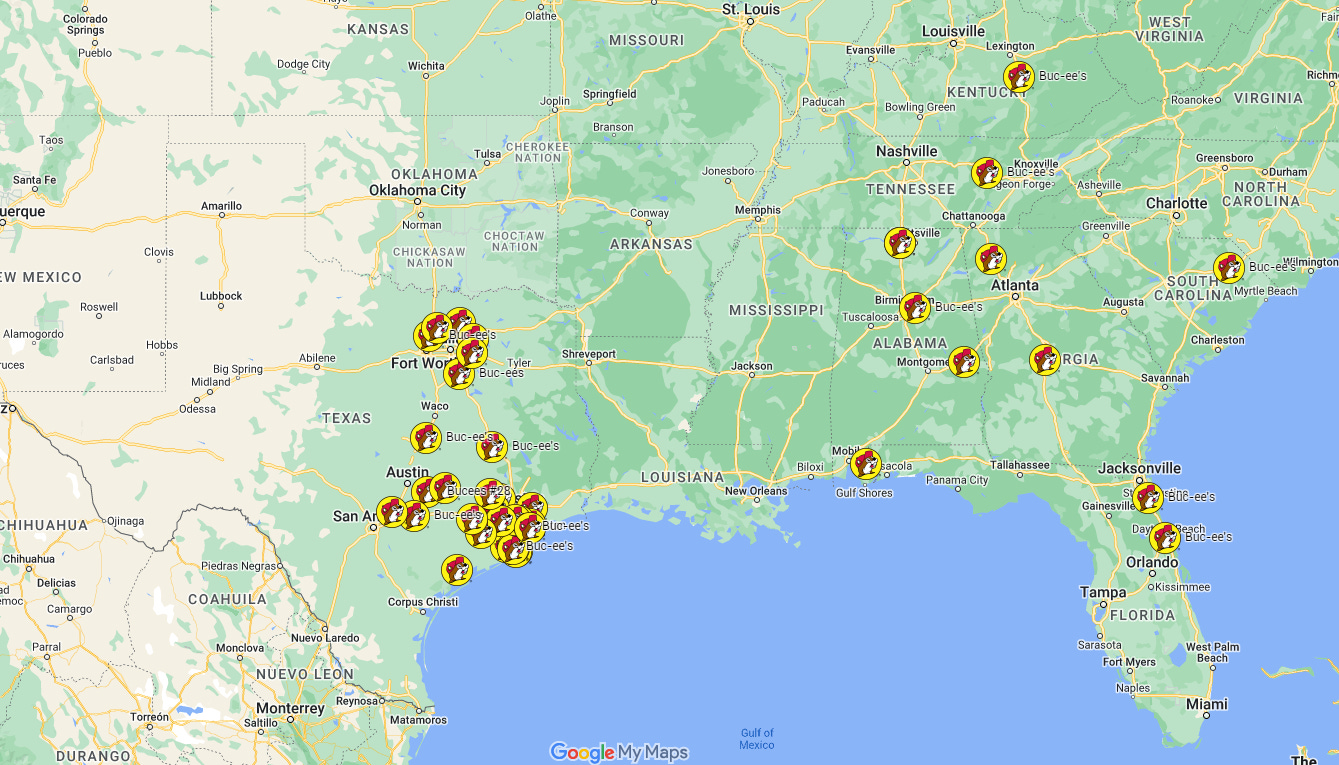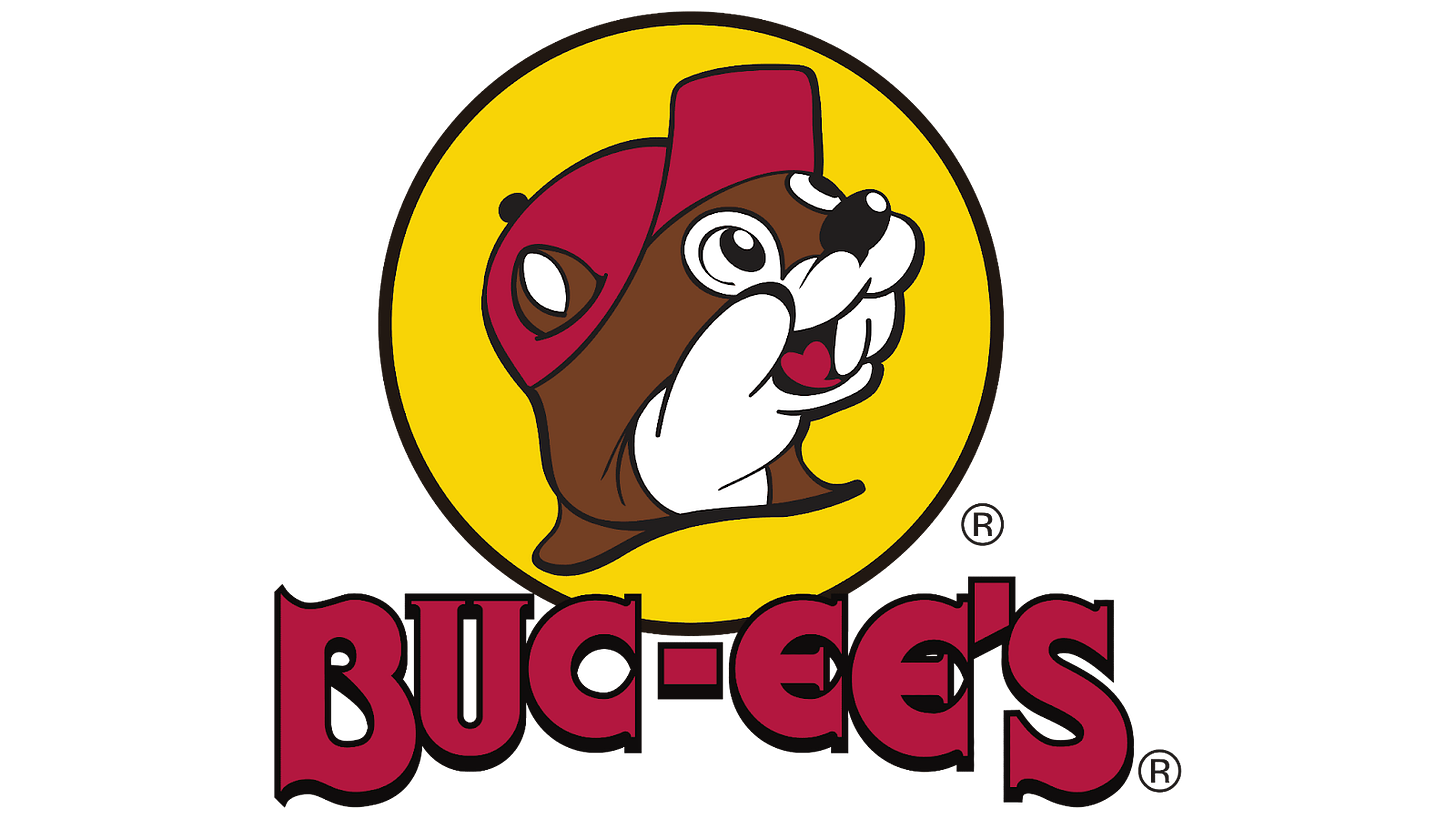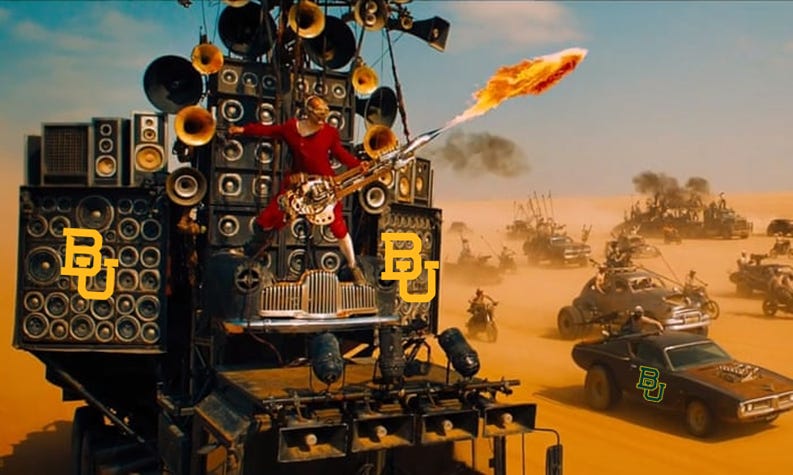Buc-ee's: A (Beaver) Tale of Execution
You Don't Always Have to Invent the iPhone
Welcome to Words with Wynn! If this is your first time perusing my content and you’d like more of my weekly musings, subscribe below:
Excellence is not mastery of a single element, but the culmination of a hundred little acts done superbly. Said another way:
“We are what we repeatedly do. Excellence, then, is not an act, but a habit.”- Aristotle, supposedly.
Today, I want to discuss a Texas establishment and a (beaver) tale of execution: Buc-ee’s.
For the uninitiated, Buc-ee’s is a chain of gas stations and travel centers dotted across the Southwest United States, famed for exceptional service, immaculate bathrooms, and a cornucopia of snackage. But to boil Buc-ee’s down to a simplistic gas station would be to massively undersell a staple of Texan road culture. The company has elevated its locations from convenience stores to destinations, a feat which leveraged supreme execution to furnish its brand with a cult-like loyalty.
On my trips from Dallas to Austin, Buc-ee’s represents a roadside mecca, an oasis in the Mad Max wastelands of Texas highways.
But these are just words. For those who have not experienced Buc-ee’s firsthand, I think memes may add perspective. A typical trip down to Austin may look something like this:
Suffice to say, the friendly beaver is a welcome sight for many a weary traveler. But where did he come from, and what’s Buc-ee’s story on the path to highway domination?
Founding & Initial Concept
The first Buc-ee’s was built by Arch “Beaver” Aplin III in Lake Jackson, Texas, in 1982. Arch had graduated from Texas A&M a few years earlier, worked at a major construction company for a short stint, and set out on his own soon thereafter. Coming from an entrepreneurial family, his father running his own construction company and his grandparents operating a small convenience store out in Louisiana, the idea to start his own business wasn’t altogether unsurprising. The initial store launch above was completed before his now iconic logo was finalized, but the beaver mascot soon followed. The name and branding was inspired by a combination of Arch’s childhood nickname “Beaver” and the name of one of his favorite hunting dogs, Buck.
The first location was a fairly standard roadside station, alittle over 3,000 square feet (slightly more spacious than the 2,400 square feet of a typical 711). It sported a few custom touches by Aplin, including some slightly nicer interior decor, but was an average gas station by most accounts. It wasn’t until he had successfully run the first shop for a few years that Aplin began to consider expansion, partnering with Don Wasek to open the second store in 1985. The second location built on the successes of the first, expanding in size to a roomier 6,000 square feet and experimenting with an on-site kitchen concept for basic food items like sandwiches. Thus began a long and fruitful partnership between the two men, co-owners of Buc-ee’s to this day.
The following decades were defined by measured, disciplined growth. The pair steadily expanded Buc-ee’s footprint to open a handful of gas stations and rest stops across Southern Texas, but it wasn’t until 2003 that the company took its first steps toward becoming the icon it is today.
Scaling & Strategy
There’s a very clear demarcation in the history of Buc-ee’s. The early days of the venture saw the company expand into a small, localized gas station chain with a healthy business and a handful of locations. Solid, but nothing to write home about. The first couple decades gave the partners an opportunity to hone their craft and cut their teeth in the convenience store business.
But 2003 was the year it all changed. That was the year that Aplin and Wasek took a big swing and opened the company’s first Travel Center in Luling, Texas.
They drew on their early successes with mixed offering convenience stores, combining regular gas and roadside fare with food and a bit of merchandise, but the first location in Luling was a different beast altogether. Originally coming in at a whopping 10,000 square feet, this travel center was a supersized offering for the standard gas station market (over 4x the standard 711 size). It has since been expanded multiple times, now sprawling out to a colossal 75,000 square feet today.
Of course some of the concept’s early success was defined by Aplin and Wasek’s discerning eye for “Location, location, location”, as the classic real estate saying goes. The Luling Travel Center is located between San Antonio and Houston directly on I-10, one of the most trafficked East-West arteries flowing across Texas. But more than the real estate itself, the Luling location took some of the battle-tested concepts from the initial Buc-ee’s fleet and combined them with a few scaled up distinctions:
Exceptional service and spotless bathrooms - this location began to really spread Buc-ee’s reputation for ease of use, exceptional service, and spotless facilities. Above all else, this cornerstone trait keeps Buc-ee’s in pull position as the destination of choice for any road-weary traveler. Each of their travel centers employs team members specifically charged with keeping the bathrooms up to snuff.
Barbeque Sandwiches - now a signature of Buc-ee’s stops, this location included brisket sandwiches, chopped and served on location, along with other substantial food offerings. This was key in catering specifically to long-distance travelers moving across the heart of Texas.
Buc-ee’s Beaver Nuggets - Luling also introduced the caramel sugar coated buttery popcorn snack that has since become another of Buc-ee’s famed fares.
Merchandise - although they’d offered merchandise before, this location’s popularity and high traffic helped to significantly speed the distribution of Buc-ee’s merchandise in lock step with its blossoming reputation.
No Truckers - The Luling Travel Center banned eighteen-wheelers. Counter-intuitively, as trucker’s are some of the most frequent long-distance travelers, Buc-ee’s banned eighteen wheelers with the intention of differentiating its location as a family-friendly pitstop. It also came with an economic incentive to reduce congestion in the parking lot and facilities (pun intended), and increase throughput of customers.
This mega model was a home run success, and the team ran with it. Today, Buc-ee’s has expanded its footprint to over 45 locations of varying size, but the hallmark of its brand is supersized centers run with the smooth efficiency of a well-oiled machine:

For me, the brilliance of Buc-ee’s is so simple, yet so potent. They didn’t invent the iPhone, and they didn’t have to. They essentially took the gamble of overlaying the original Walmart business model onto the roadside convenience store industry, combining militaristic execution with economies of scale, all buttressed by a vastly superior customer experience.
And this strategy has paid off, handsomely.
“Two years before the Luling store opened, the chain’s sales totaled $63 million, according to a court filing. By 2006, when the Luling store expanded from 10,000 to 17,000 square feet, total sales had more than tripled to $202 million. In 2015 the company took in $959 million. Since then, Aplin and Wasek have opened up four more 50,000-square foot stores.” - from Eric Benson’s superb Buc-ee’s writeup in Texas Monthly
Though, it isn’t enough to simply gawk at the top-line sales figure to really appreciate Buc-ee’s edge. A billion dollars in revenue is only so good as the cash it mints on the back end, of which Buc-ee’s prints plenty. What allows Buc-ee’s to generate superior returns and continue to dominate its competition?
Of course there’s the massive scale inherent in their business. Running larger stations allows Buc-ee’s to capture economies of scale and spread costs across its various locations. This weight also helps when Buc-ee’s needs to negotiate major purchases with vendors, especially in the particularly ruthless purchasing/selling of gasoline. Because of the undifferentiated nature and high amount of competition around selling gas, it’s an incredibly low margin component of the convenience store business (low single digits), and requires vendors to move significant volumes. Not only can Buc-ee’s push volume at the pumps, but they can accept lower margins on the gas itself as a loss leader to drive foot traffic into their centers, where higher margin snacks and merchandise abound.
Though, what really allows Buc-ee’s to drive superior profitability is its elevated position as a brand. In addition to the ginormous locations themselves, Buc-ee’s is famed for its limitless snack options and beloved beaver merchandise. You’ll notice in the store that that adorable little beaver face is slapped on nearly every snack you can think of. This is known as White-labeling, where a generic product like pretzels is produced in bulk by a third party, and then the brand itself slaps its labeling on the product before sale. The combination of in-house Buc-ee’s specialty products, like their brisket and Beaver Nuggets, and their multitude of white labeled snacks allows Buc-ee’s to generate wider margins on their snack sales.
Forbes did a nice breakdown of what this means for the business:
“Aplin says 10% to 12% of the packaged food sold at Buc-ee's is Buc-ee's-branded. Forbes estimates that Buc-ee's profit margin on major-label items is 32%, while its margins on Buc-ee's-branded stuff is 40%. Overall, Forbes estimates, the company managed to take a 35% gross profit margin on in-store sales (everything but gas). According to the National Association of Convenience Stores, the average convenience store made 33.5% on in-store sales. Last year, the NACS says, the average convenience store operator had overall net profits of 1.8%. Aplin says Buc-ee's did better than that but declined to be more specific.”
Their meandering store concepts, Aplin’s idea, also provide ample retail space for general merchandise of every shape and size- everything from Buc-ee’s branded koozies and t-shirts to deer feeders and buckets of bacon grease.
Branding & Loyalty
Although the roadside experience speaks for itself, it never hurt to have some brilliant marketing to spread your gospel as well. In Buc-ee’s case, this came from an engagement in 2006 with Stan & Lou, a Houston advertising firm, that helped the company to refine its messaging into the playful eager-beaver we know and love today. The company couples its militaristic execution with light-hearted branding that emphasizes Buc-ee’s defining features (snack selection, spotless bathrooms) while projecting a playful nature, all displayed across miles and miles of billboards leading up to any given stop:
The over-the-topness of their advertising pairs with the vastness of their stops to fit a uniquely “Everything’s Bigger in Texas” brand identity that deeply resonates with consumers from the Lone Star State, and progressively elsewhere too (as they’ve proven over the last few years). The strength of their brand also serves as a differentiated flywheel whereby their consumers proselytize the company on their behalf.
On any given weekend, floating Ladybird Lake in Austin, you will see at least one Buc-ee’s bathing suit, cooler, koozie, or sun hat. Texans, from your salt of the earth farmer to your bougie MBA students, unironically rock the Beaver merchandise. It’s amazing to me that a simple gas station has been able to build such a fervent following, and represents a very real moat for the business. Consumers will heed their advertising and push their bladder an extra few miles if it means enjoying the sparkling bathroom of their favorite Buc-ee’s as opposed to any number of other roadside gas stations.
Furthermore, it’s interesting to consider how low (relatively) their ad spend probably is versus competitors. How many gas station commercials have you seen versus Buc-ee’s $0 cable/digital ad spend, almost exclusively devoting their marketing dollars to billboards alone? The company knows when, where, and how to both reach and delight its customers in a fashion unparalleled in the grimy industry of roadside gas stops.
Conclusion
From an eager beaver to a bustling national roadside chain, Buc-ee’s has upended the traditional gas station business through a bit of innovation and a lot of hustle. Aplin and Wasek have continued to push the envelope of what a roadtrip pitstop can be, racking up a few world records along the way. Buc-ee’s is a standout case study of the power of branding in elevating a commoditized product into a differentiated experience.
Stay hustlin’
- 🍋












